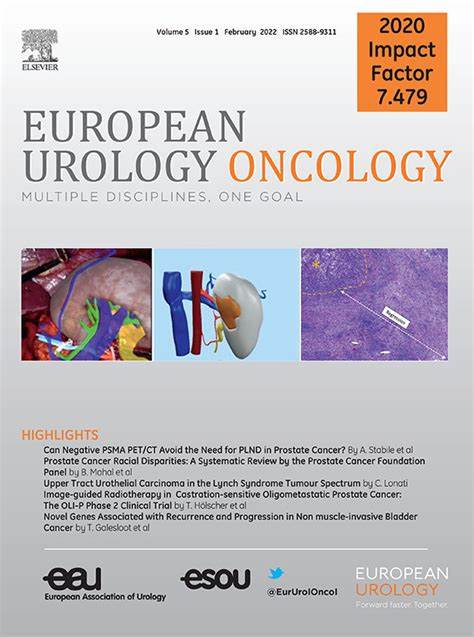Final Results of the ANDROCAN Study: Histopathological Characteristics and Biochemical Recurrence at 5 Years of Localized Prostate Cancer According to Preoperative Gonadal Status
IF 9.3
1区 医学
Q1 ONCOLOGY
引用次数: 0
Abstract
Background and objective
Failure rates after first-line treatment of localized prostate cancer (PCa) treatment remain high; therefore, it is essential to improve the selection and identification of at-risk patients to reduce mortality. The aim of the ANDROCAN study was to evaluate the biochemical recurrence (BCR) in patients with localized PCa treated by total prostatectomy at 5 yr after surgery, according to their presurgery gonadal status.
Methods
A prospective cohort study was conducted including 1318 patients undergoing total prostatectomy for localized PCa with a 5-yr postoperative follow-up. Clinical and hormonal data (assays of total testosterone [TT], bioavailable testosterone [BT], dihydrotestosterone, estrone, and estradiol were performed by gas chromatography/mass spectrometry) as well as metabolic syndrome parameters were collected at baseline before surgery. Pathological data (predominant Gleason grade 4 and stage) were collected and cross-referenced centrally. Factors associated with BCR were assessed by a multivariate analysis, and BCR-free survival was assessed by a Kaplan-Meier analysis.
Key findings and limitations
Among the 1318 patients, 237 had BCR of PCa. Considering demographic characteristics, populations with and without BCR were similar. However, patients with BCR had cancers with a higher Gleason score (p = 0.0001) and higher prostate-specific antigen (PSA) values (p = 0.0005) at baseline. Gleason score, pT >3a, and PSA level at baseline were positively correlated with BCR (p < 0.0001, p < 0.0001, and p = 0.0048, respectively), while BT and TT levels were not associated with BCR. This study includes patients with varying clinical characteristics, such as cancer history and metabolic syndrome, introducing variability that makes it challenging to isolate the specific effects of gonadal status on BCR. Another limitation is the lack of evaluation of long-term BCR beyond 5 yr, potentially overlooking recurrences that occur between 5 and 15 yr after surgery. This could lead to an underestimation of the actual long-term recurrence rates.
Conclusions and clinical implications
Overall, PSA levels, high Gleason score, and pT >3a are associated with a greater likelihood of disease recurrence following initial treatment and could serve as important prognostic indicators for predicting the risk of BCR. In this prospective study, biochemical hypogonadism was not associated with a higher occurrence of BCR within 5 yr of prostatectomy. The biological gonadal status of preoperative patients could potentially be useful for therapeutic decisions but does not provide an indication for the oncological follow-up.
Patient summary
Five-year follow up of patients after surgery showed that there is no association between hypogonadism (low levels of total testosterone and bioavailable testosterone) and cancer recurrence. However, cancer recurrence seems to be more associated with aggressiveness of cancer at the time of detection.
ANDROCAN 研究的最终结果:根据术前性腺状态确定局部前列腺癌的组织病理学特征和 5 年后的生化复发率。
背景和目的:局部前列腺癌(PCa)一线治疗后的失败率仍然很高;因此,必须改进对高危患者的选择和识别,以降低死亡率。ANDROCAN研究的目的是根据患者术前的性腺状况,评估接受全前列腺切除术治疗的局部前列腺癌患者术后5年的生化复发率(BCR):这项前瞻性队列研究包括1318名接受全前列腺切除术治疗局部PCa的患者,术后随访5年。临床和激素数据(通过气相色谱/质谱法检测总睾酮[TT]、生物可利用睾酮[BT]、双氢睾酮、雌酮和雌二醇)以及代谢综合征参数均在手术前收集。收集病理数据(主要的格里森4级和分期)并进行集中交叉比对。通过多变量分析评估了与BCR相关的因素,并通过卡普兰-梅耶尔分析评估了无BCR生存率:在1318名患者中,237人患有PCa BCR。考虑到人口统计学特征,有BCR和无BCR的人群相似。然而,BCR患者的癌症在基线时Gleason评分更高(p = 0.0001),前列腺特异性抗原(PSA)值更高(p = 0.0005)。基线时的 Gleason 评分、pT >3a 和 PSA 水平与 BCR 呈正相关(p 结论和临床意义:总体而言,PSA 水平、高 Gleason 评分和 pT >3a 与初始治疗后疾病复发的可能性增加有关,可作为预测 BCR 风险的重要预后指标。在这项前瞻性研究中,生化性腺功能低下与前列腺切除术后 5 年内 BCR 发生率较高无关。术前患者的生化性腺状态可能有助于治疗决策,但并不能作为肿瘤随访的指征:对术后患者的五年随访显示,性腺功能低下(总睾酮和生物可利用睾酮水平低)与癌症复发之间没有关联。不过,癌症复发似乎与发现时癌症的侵袭性更相关。
本文章由计算机程序翻译,如有差异,请以英文原文为准。
求助全文
约1分钟内获得全文
求助全文
来源期刊

European urology oncology
Multiple-
CiteScore
15.50
自引率
2.40%
发文量
128
审稿时长
20 days
期刊介绍:
Journal Name: European Urology Oncology
Affiliation: Official Journal of the European Association of Urology
Focus:
First official publication of the EAU fully devoted to the study of genitourinary malignancies
Aims to deliver high-quality research
Content:
Includes original articles, opinion piece editorials, and invited reviews
Covers clinical, basic, and translational research
Publication Frequency: Six times a year in electronic format
 求助内容:
求助内容: 应助结果提醒方式:
应助结果提醒方式:


